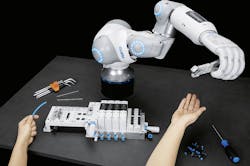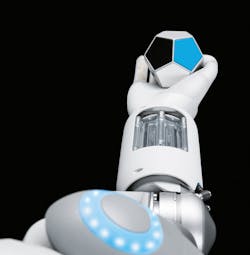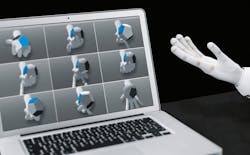Festo’s Bio-Pneumatic Robotic Hand and Arm Meet Artificial Intelligence
The human hand boasts a unique combination of power, dexterity, and fine motor skills. We use it everyday whether its grabbing, holding, turning, touching, or pressing objects. In the world of robotics, trying to replicate human motion has always been a goal because it makes integrating them into human work environments easier. Several robotic arms have grippers that can replicate at least one aspect of the human such as picking, grabbing, turning, or applying force.
To help create a more complex end effector, Festo will be demonstrating their new robotic hand the BionicSoftHand at Hanover Messe Fair 2019. With its new robotic hand, Festo looks to introduce a new tool for human and robotic collaboration.
The BionicSoftHand is operated pneumatically for safe and direct interaction with people.
The BionicSoftHand
The BionicSoftHand is a pneumatically operated end effector that mimics the hand motion of a human being. It will operate in conjunction with Festo’s Future Concept BionicSoftArm. Both the hand and arm are safe to interact with due to their pneumatic operation method. Mimicking the motion of the human hand is no easy feat and using pneumatics provides a more controlled and detailed movement profile. The hand’s fingers consist of flexible bellows structures with air chambers. The bellows are enclosed in the fingers by a 3D textile coat knitted from elastic and high-strength threads. The textile allows engineers to determine exactly where the structure expands and generates power, and even where it is prevented from expanding. The hand can exert strong forces while still being light and flexible.
The key pneumatic component which allows for minimal tubing is the digital control proportional piezo valve terminal directly mounted on the hand. The tubes for controlling the gripper fingers do not have to be pulled through the entire robot arm. Rather, they can sit at the hand, making it easy for quick disconnect; they are operated with only one tube each for air supply and air exhaust. The piezo valves enable precise control over the finger’s movements.
The pneumatic lightweight robot BionicSoftArm is flexible from the start and is suitable for direct human-robot collaboration.
The BionicSoftArm
The BionicSoftArm is continuation of Festo’s work on the BionicMotionRobot. The SoftArm is more compact and can be combined with up to seven pneumatic bellows segments and rotary devices. This provides a long range of flexibility, reach, and mobility, allowing it to work around tightly spaced obstacles. The pneumatic actuation, just like in the SoftHand, allows for safe operation around people.
Direct human-robot collaboration is important in developing new automation segments. The BionicSoftHand and Arm can be used in SCARA applications, such as pick-and-place tasks, and in cobot applications with direct human interaction. Work ranges are continuing to see increases in overlap and collaborative work spaces are increasing in the automation field.
The BionicSoftArm as a classic SCARA application with a pick-and-place task: It can work in the tightest of spaces around obstacles. It also learns via feedback based machine learning.
Using Feedback Learning for Programming
Positive and negative based feedback are how both humans and machines learn. We each require feedback to refine our previous actions. Using machine learning, the BionicSoftHand uses reinforced learning to create more efficient movement.
The AI built-in the SoftHand uses the trial and error method to achieve its goal. For example, the robot is told to rate a 12-sided cube so that a previously defined side is pointed upward at the end. The necessary movement strategy is taught in a virtual environment via a digital twin, which is created with data collected from a depth-sensing camera via computer vision and the algorithms of artificial intelligence. The hand will rotate the cube and—based on positive and negative feedback from the robot—will teach itself the correct sequence, optimizing its actions until the task is complete.
“The topics of analytics and artificial intelligence will enormously influence our product portfolio in future,” explains Dr Frank Melzer, a member of Festo’s management board. “For simple analysis tasks, AI algorithms can run directly on the component in real time; we then speak of field level or on-edge.
“If I want to analyze the data flows of an entire machinery unit or even a production hall, the processing power within the component will of course not be sufficient,” Melzer continues. “The servers for the more complex calculations can be integrated into the production network. The advantage: My data remain within my protected infrastructure and are not communicated via the internet. It is only in the processing of very large volumes of data with complex analyses and reference series that communication with the cloud is necessary and appropriate.”
The robotic arm is becoming the go-to tool for collaborative environments. The main hurdle preventing faster adoption is its flexibility. Festo hopes to solve this problem by introducing human-like movement features to the robotic design. The BionicSoftHand and Arm’s flexible kinematics make it easier for it to adapt to different human-based takes while also making it safer to interact with human workers. The inherent safety of the robotic arm also helps to eliminate costly safety devices such as cages and light barriers, lowering conversion times and enabling flexible use.




